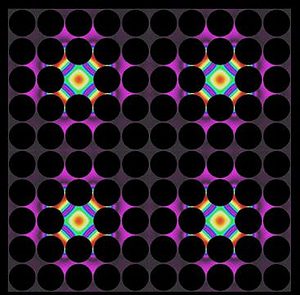A materials science researcher at MIT has devised a novel technique using nanoparticles that allows heat flow to be treated much in the same way as light. This means that like electromagnetic waves, heat was successfully focused and reflected. The findings could help spark further research which might one day aid in the development of highly efficient electronics, smart heat directors and more.

Precisely spaced air gaps (dark circles) control the flow of heat, thermal energy can be “pinned” in place by defects introduced into the structure (colored areas).
Illustration courtesy of Martin Maldovan
Heat is actually the vibration of matter. Unstable matter, for instance, will typically have its individual molecules and atoms vibrate with a higher frequency, leading to a lot of heat being dispersed. The vibrations can be thought of as a stream of phonons or imaginary particles similar to photons that carry light. This thinking is instrumental in devising a method that treats heat analogous to light.
Martin Maldovan, a research scientist in MIT’s Department of Materials Science and Engineering made materials consisting of nanostructured semiconductor alloy crystals equipped with tiny gaps spaced just in right way that they match the wavelength of the heat phonon.
The new technique is similar in working principle to the recently developed photonic crystals that can control the passage of light, and phononic crystals that can do the same for sound. Heat and sound can be compared to an extent, since they both represent vibrations. However sound consists of lower frequencies (up to the kilohertz range, or thousands of vibrations per second), while heat works on very high frequencies in the terahertz range or trillions of vibrations per second.
“Phonons for sound can travel for kilometers,” Maldovan says — which is why it’s possible to hear noises from very far away. “But phonons of heat only travel for nanometers [billionths of a meter]. That’s why you couldn’t hear heat even with ears responding to terahertz frequencies.”
Focusing and reflecting heat
To overcome this issue, Maldovan had to tune down the heat frequencies to the boundary zone between heat and sound. Making alloys of silicon that incorporate nanoparticles of germanium in a particular size range, along with disposing a series of thin films of the material, so that scattering of phonons would take place at the boundaries, accomplished this lowering of frequency. This allowed heat vibrate 100 to 300 gigahertz, and most of the phonons to align in a narrow beam, instead of moving in every direction.
This narrow beam is maybe the most interesting feature of the technique, since it virtually allows phonons of heat to be manipulated using phononic crystals similar to those developed to control sound phonons. Maldovan refers to them as “thermocrystals,” a new category of materials.
Heat typically escapes matter through all directions, using a thermocrystal however heat can be directed. For instance, heat could be forced to exit through a direction, but not in the reverse direction. Also, heat could be focused – like light with lens – to concentrate heat. A possible military application for the technique could be thermal cloaking, preventing the detection of heat.
Findings were detailed in the journal Physical Review Letters.
source: MIT News









